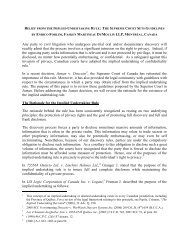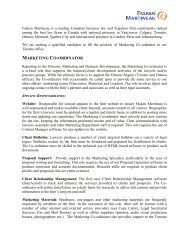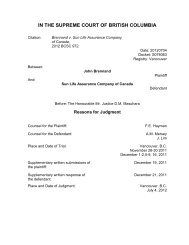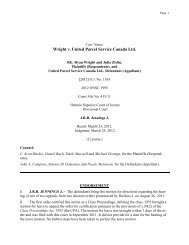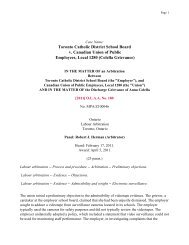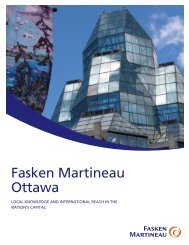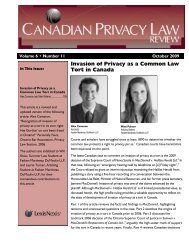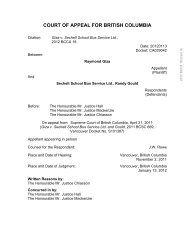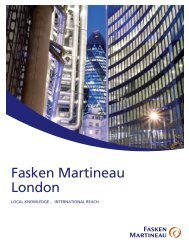Dabic v. Windsor Police Services
Dabic v. Windsor Police Services
Dabic v. Windsor Police Services
Create successful ePaper yourself
Turn your PDF publications into a flip-book with our unique Google optimized e-Paper software.
HUMAN RIGHTS TRIBUNAL OF ONTARIO______________________________________________________________________B E T W E E N:Mirko <strong>Dabic</strong>Applicants-and-<strong>Windsor</strong> <strong>Police</strong> ServiceRespondent______________________________________________________________________2010 HRTO 1994 (CanLII)DECISION______________________________________________________________________Adjudicator:David A. WrightDate: September 29, 2010File Number:2009-03983-ICitation: 2010 HRTO 1994Indexed as:<strong>Dabic</strong> v. <strong>Windsor</strong> <strong>Police</strong> Service______________________________________________________________________
INTRODUCTION[1] Officers of the respondent <strong>Windsor</strong> <strong>Police</strong> <strong>Services</strong> arrested the applicant onJanuary 8, 2009 and charged him with two counts of domestic assault, which were laterwithdrawn. The arrest followed calls to the police by the applicant’s son in which headvised that his father had a mental illness, and alleged that the applicant had beendrinking and had assaulted his wife. The applicant alleges that his arrest and “torture”by the police were discriminatory on the basis of ethnic origin and disability. He statesthat this was discrimination on the basis of ethnic origin because he is a Serbian personand on the basis of disability because the police drove him to the hospital and later puta disabled person in jail.2010 HRTO 1994 (CanLII)[2] Following an Interim Decision finding that the allegations appeared to be withinthe Tribunal’s jurisdiction, 2010 HRTO 745 (CanLII), the Application was delivered tothe respondent, which filed a complete Response attaching the “<strong>Windsor</strong> <strong>Police</strong> ServiceNarrative Text Hardcopy” about the incident, which included the officers’ narrative andthe statement of the applicant’s son. The respondent made various preliminaryobjections, including asking for the Application to be dismissed pursuant to s. 45.1 ofthe Code.[3] By Case Assessment Direction dated July 9, 2010, the Tribunal, on its owninitiative, directed that the matter be scheduled for a Summary Hearing pursuant to Rule19A of the Tribunal’s Rules of Procedure. It stated as follows at para. 3:In my opinion, the most appropriate procedure, given the issues raised inthe Application, is to hold a summary hearing on whether the Applicationhas a reasonable prospect of success. In particular, the parties shalladdress the issue of whether there is a reasonable prospect that theapplicant can prove, on a balance of probabilities that he wasdiscriminated against on the basis of ethnic origin or disability by theactions of the police that he challenges. The parties shall also beprepared to address the issue of whether the Application should bedismissed pursuant to s. 45.1 of the Code as requested by therespondent. The applicant shall make his submissions first during theteleconference.
The Case Assessment Direction also directed the respondent to disclose to theapplicant any records relating to the incidents in question that had not already beenprovided to the applicant. The Summary Hearing was held on September 8, 2010.DECISION[4] The Application does not have a reasonable prospect of success and it isdismissed.ANALYSIS2010 HRTO 1994 (CanLII)Summary Hearings[5] Rule 19A deals with Summary Hearings. It came into effect on July 1, 2010, andreads as follows:19A.1 The Tribunal may hold a summary hearing, on its own initiative orat the request of a party, on the question of whether an Application shouldbe dismissed in whole or in part on the basis that there is no reasonableprospect that the Application or part of the Application will succeed.19A.2 Rules 16 and 17 do not apply to summary hearings. The Tribunalmay give directions about steps the parties must take prior to thesummary hearing, including disclosure or witness statements.19A.3 When a party requests that an Application be dismissed pursuant tothis Rule, it shall deliver to the other parties and file with the Tribunal aRequest for Summary Hearing (Form 26), which includes full argument insupport of the Request that the Application be dismissed. The partymaking the Request shall also deliver to the other parties a copy of thePractice Direction: Summary Hearing Requests.19A.4 A party may respond to the Request for Summary Hearing bycompleting Form 11, delivering a copy to all parties and filing it with theTribunal not later than 14 days after the Request for Summary Hearingwas delivered.19A.5 Upon review of the Request and any Response to the Request, theTribunal will determine whether to hold a summary hearing on thequestion of whether the Application should be dismissed, in whole or in2
part, on the basis that there is no reasonable prospect that the Applicationwill succeed. The Tribunal need not give reasons for a decision to hold ornot to hold a summary hearing following a party’s request.19A.6 Where the Tribunal decides not to dismiss an Application followinga summary hearing, it need not give reasons.[6] The issue before me in determining this Summary Hearing is whether theApplication has “a reasonable prospect of success” within the meaning of Rule 19A.1.The Tribunal’s jurisprudence on this question will develop as the standard is applied todifferent factual situations, and I believe it is not appropriate, at least at this early stagein the application of Rule 19A, to set out a definitive test or standard about the meaningof this phrase. I do make some initial observations about the type of inquiry that may beinvolved in a summary hearing.2010 HRTO 1994 (CanLII)[7] A summary hearing is generally ordered at an early stage in the process. Insome cases, the respondent may not have been required to provide a response. Inothers, the respondent may have responded but disclosure of all arguably relevantdocuments and the preparation of witness statements, which generally occur followingthe Notice of Hearing, will not yet have happened.[8] In some cases, the issue at the summary hearing may be whether, assuming allthe allegations in the application to be true, it has a reasonable prospect of success. Inthese cases, the focus will generally be on the legal analysis and whether what theapplicant alleges may be reasonably considered to amount to a Code violation.[9] In other cases, the focus of the summary hearing may be on whether there is areasonable prospect that the applicant can prove, on a balance of probabilities, that hisor her Code rights were violated. Often, such cases will deal with whether the applicantcan show a link between an event and the grounds upon which he or she makes theclaim. The issue will be whether there is a reasonable prospect that evidence theapplicant has or that is reasonably available to him or her can show a link between theevent and the alleged prohibited ground.3
[10] In considering what evidence is reasonably available to the applicant, theTribunal must be attentive to the fact that in some cases of alleged discrimination,information about the reasons for the actions taken by a respondent are within the soleknowledge of the respondent. Evidence about the reasons for actions taken by arespondent may sometimes come through the disclosure process and through crossexaminationof the people involved. The Tribunal must consider whether there is areasonable prospect that such evidence may lead to a finding of discrimination.However, when there is no reasonable prospect that any such evidence could allow theapplicant to prove his or her case on a balance of probabilities, the application must bedismissed following the summary hearing.2010 HRTO 1994 (CanLII)Application to the Facts[11] During the summary hearing, the applicant made limited submissions. Theyincluded his allegation that his family was trying to remove him from his apartment bytrying to increase his anxiety. He stated that his family and the police officer havesomething unknown against him. He submitted that he was certain that his wife has afriend in the police station who was using police officers to remove him from hisresidence, and that he was discriminated against and harassed by his wife and son.[12] In my view, there is no reasonable prospect that the applicant can provediscrimination or harassment on the basis of ethnic origin or disability by the respondent<strong>Windsor</strong> <strong>Police</strong> Service. It is evident that the police received a call from his family andarrested him based on the allegations of assault and the officers’ observations. There isno information in the police file or that is reasonably likely to be available that wouldsuggest a link between his arrest and his ethnic origin or disability. Although there hasbeen disclosure of the police file, the Tribunal has before it only a bald allegation ofdiscrimination with nothing to suggest that the actions of the police were connected withgrounds under the Human Rights Code. In addition, there is no general principle, assuggested by the applicant, that it is a violation of the Code for a person with a mentaldisability to be brought to jail upon arrest rather than to a psychiatric facility.4
[13] Accordingly, there is no reasonable prospect that the Application will succeedand it is dismissed.Dated at Toronto, this 29 th day of September, 2010.“Signed by”__________________________________David A. WrightInterim Chair2010 HRTO 1994 (CanLII)5



